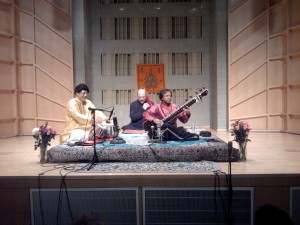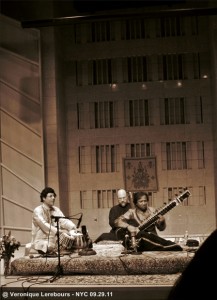Date: September 29, 2011
Venue: Baruch College
Concert review by Dawoud Kringle
On Thursday, September 29th, I attended Ustad Shahid Parvez Khan’s concert at Baruch College which was organized by SangeetSabha. It was my third time seeing him live. He was joined by Pandit Anindo Chatterjee on tabla.
His first set featured Raag Bageshri: a night time raga attributed to Mian Tansen. He began with an alap. Raag Bageshri is an intensely emotional raga of longing; and apart from the monumental technical prowess required to play a raga correctly, if one cannot evoke these emotions in the music, and in the hearts of the listeners, they are presenting mere mathematics. This, of course, is not the case with Ustad-ji; he always enters deeply into the essence of the raga, and the listener cannot help but feel exactly those emotions. Yet at the same time, he playfully conjures the nearly superhuman displays of technical pyrotechnics that are his trademark; and then smiles as if he’s sharing a joke with you. And you are left gasping at the amazing feats of virtuosity, and the overwhelming emotional content of the music.
There are often moments of virtuoso performances by great musicians that stand clear in my memory. I specifically remember at one point he spent some time on the the komal ga (what Western music would vaguely describe as a minor third). He took great pains exploring all the possible contours of that one note; and producing with one note more music than many people could playing every note on their instrument for hours.
Then Pandit Chatterjee came in and made a powerful musical statement. From the first bol, his technical achievements were more than obvious. But what was truly impressive was the way he was able to evoke the same mood of the raga within the tonal quality of his tabla, and within the bols he was playing!
The two men complimented each other’s playing perfectly. They knew instinctively what each was going to do before they did it, and often improvised some phrases of mind shattering complexity at a moments notice that most people couldn’t play with hours of pre-arranged practice.
At one point, they actually stopped playing. They’d been playing in Ektal (a cycle of 12 beats) and Ustad-ji said. “We have been playing in ektal, but I changed my mind. We’ll play in rupak tal. (Rupak tal is a 7 beat cycle).” I ask the reader to consider what it would take to switch time signatures at the drop of a hat; and continue to play at the same amazing level of virtuosity they had previously. The raga ended in a jhalla of blinding speed and intricate interplay between the two instruments.
After an intermission, they returned and played Raag Sham Kalyan. This piece was performed with a lyrical delicacy that showed a very different emotional content than his interpretation of Raag Bageshri. The whole piece gave the impression that he was improvising a love poem, rather than merely interpreting a classical musical form. There was no jhalla.
Pandit Chatterjee continued to intersperse the bols on his tabla with astonishing virtuosity and musical sensitivity. He was enjoying showing the audience his mastery of his instrument, yet there was no braggadocio. Never once did he sacrifice musical beauty and meaning for mere showmanship.
They ended this set with Anar Anar, a piece based on Misra Khamaj. This is something that he usually ends his performances with. Somehow, this night’s approach to this piece was different. It was as joyful as always; but seemed to relinquish some of the sense of playfulness he often puts into it. He was more serious.
The audience offered the two maestros a standing ovation; and a final piece was requested of them. By now, some of the audience had left (it being a Thursday night, many people presumably had to go to work the following morning). But many of us remained; unwilling to miss a single note.
They played Raag Bhairavi. This raga is as popular as it is unique. Most treatises on it will explain to the Westerner that it is akin to the Western Phrygian mode. But there is much more to this raga than strict adherence to a mode. It is capable, in the hands of a great musician, of evoking many moods and musical colors. This night, Ustad Khan brought out things in this raga I never knew was possible in it, and I have heard many interpretations of it. It was as if one were walking in a forest of sound, and Ustad-ji was, by the Creator’s permission, commanding flowers to bloom, trees and bushes to grow and change color, vines to bear grapes, and rain to fall at will.
Every time I hear Ustand-ji it is a new experience. There is something about the sheer beauty and depth of emotion of each performance that is utterly unique. Words often fail me to describe it. Listening to recordings or watching videos of this maestro is not at all like actually being in the same room with him offering a performance. I highly recommend attending his performances. Familiarity with Indian classical music, while helpful, is not necessary in being rapt by the overwhelming sublimity of Ustad-ji’s music, no more than if we could attend a performance by Beethoven or John Coltrane. The human ear, and the heart and soul it is inexorably connected to, cannot hear more beautiful music.
Read more about Shahid Parvez Khan





